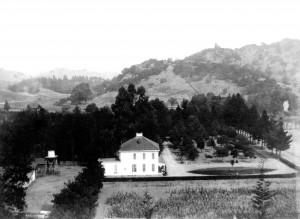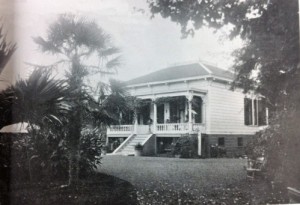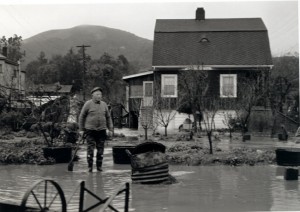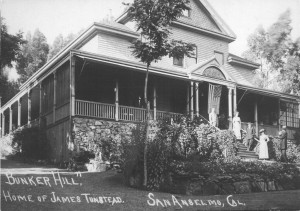James and Mary Tunstead were prominent early residents of San Anselmo. James Tunstead donated the land where Town Hall and the Library are now, and the nearby street is named in his honor.
The Tunsteads had three beautiful homes in San Anselmo. The first, called Linda Vista, and the third, Bunker Hill, have previously been documented in the historical record. Information about their second home, Magnolia Cottage, has only recently been discovered.
Linda Vista
Mary was the widow of James Ross Jr. and came to the Ross Valley when she married Ross in 1865. James and Mary Ross lived at Linda Vista, a lovely two-story wood-framed house on landscaped grounds. It was located about halfway up today’s Tunstead Avenue.
James Tunstead, born in Ireland, came to Marin in 1866 and took up farming in Novato. In 1875, he was elected County Sheriff and served until 1880. He married Mary Ross in 1878. Shortly after their marriage, they leased Linda Vista and moved to a new home in San Anselmo. Eventually, Linda Vista was converted into a hotel with several different managers over the years. In the early 1900s, the Linda Vista Hotel offered rooms for 90 guests in a natural park of 20 acres. There was a large dining room, dance floor, and tennis courts. James Tunstead sold the property in 1912, and the building was torn down in 1918.
Magnolia Cottage
James and Mary called their new home in San Anselmo Magnolia Cottage. It was not far from Linda Vista.
It was located near the creek at what is today Magnolia and San Anselmo Avenues with a large stable to the rear. The Sausalito News reported in August 1885 on a garden party given by the Tunsteads at Magnolia Cottage. “The table was laid in a delightful spot, sheltered by a growth of natural vines and ferns, from which splendid views of the neighboring hills and canons could be obtained. What nature had forgotten was supplied by the taste and forethought of the hosts, whose gardens were despoiled of their choicest blossoms to add beauty and color to the scene. Hammocks, too, suggestive of ease and repose, were swung in the fair retreat, and the softest cushions and easiest chairs courted the company of the merry guests, while the table appointments not only pleased the eye but gratified the most fastidious fancies of the inner man.”
In 1896, the Tunsteads moved to San Rafael while a new home was being built for them overlooking San Anselmo’s hub. They leased Magnolia Cottage for five years to Peter Caramelli who intended to enlarge it and open it as a first-class hotel.
Caramelli was known as the “prince of chefs and caterers.” He learned to cook as a young boy in his native Italy and by age 18 was head chef in the Spanish court. In California he cooked at the Hotel Rafael and San Francisco’s famed Poodle Dog Restaurant before coming to San Anselmo with his wife Virginia. The hotel was called the Greyhound, and given Caramelli’s reputation, the restaurant associated with it was destined to be San Anselmo’s first gourmet eating establishment.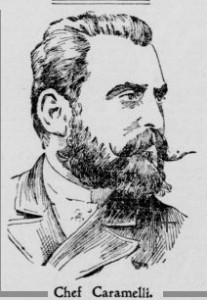
But difficulties first came for Caramelli when he applied for a liquor license in January 1897. William Barber and Dr. Robert MacKenzie of the San Francisco Theological Seminary spoke for the protestors before the Board of Supervisors and vehemently opposed the granting of a license. MacKenzie said “You have your choice of having one of these institutions, the saloon or the college, but not both.” James Tunstead pleaded on behalf of Caramelli but the supervisors unanimously denied the license.
In October 1897, Peter Caramelli died at age 47. The San Francisco Call wrote that “his ragouts were inimitable, his salamis a dream” and that “gourmets will weep” at his death.
Virginia Caramelli continued on with the hotel and restaurant. In the summer of 1898, the Greyhound Hotel advertised its large, shaded grounds, 50 minutes from the city with special terms for families. Virginia sold out to Amedeo Sessia and Louis Parisot in late 1899.
James and Mary Tunstead sold the entire property, one lot deep on either side of Magnolia Avenue from the creek to Cedar Avenue, to Carlo (Charles) and Emilia Pizochero in June 1900. The Pizocheros, natives of Italy, moved to San Anselmo from San Francisco where Charles had been a baker and then an importer of French and Italian groceries. They subdivided Magnolia Tract in 1904, retaining the hotel and a large plot of land at the eastern end of the tract.
By 1906, Jean Cazeaux, a native of France and experienced hotelier, was managing the hotel and restaurant. He called it Villa Cazeaux. The hotel advertised 22 rooms, a dining room and stable on one acre. Open all year, it boasted telephone service and electric lights. Cazeaux disposed of his interests in the hotel in 1915.
Meanwhile the Pizocheros built two new cottages in the garden of the old hotel and offered them for sale. Their own home was on the southeast corner of today’s Magnolia Avenue and Library Place.
With James Tunstead’s donation of land for the Town Hall in 1910, the area was destined to become the center of the town’s business activity. In 1916, Pizochero constructed a building at 535 San Anselmo Avenue which originally housed the post office, a dry goods, meat market and candy store. It was later home to Rossi Bros. Pharmacy.
The hotel and restaurant continued under the management of Emilio Chirone until 1920 when he was arrested for selling liquor during Prohibition and had his business license revoked. By 1923, the hotel building, originally the Tunstead’s Magnolia Cottage, was gone, replaced by the building at 607-615 San Anselmo Avenue. The restaurant building was remodeled for George Tong’s Panama Market, and then became the home of Louis Kientz’s San Anselmo Bakery.
Bunker Hill
The Tunsteads moved into to their new home in the spring of 1897. They called this one Bunker Hill. They planted an extensive garden and trees to protect from the wind. There were outbuildings and a home for their housekeeper on the property.
When the Tunsteads died, Mary in 1909 and James in 1912, their heirs sold Bunker Hill to San Anselmo hardware merchant Achille Bonaiti and his wife, Celia. The Bonaitis continued to maintain the beautiful home and gardens. After the their deaths, the house was demolished and replaced about 1960 by the apartment building we see today.
The Tunstead’s homes – Linda Vista, Magnolia Cottage, Bunker Hill – are now long gone, their graceful presence in the valley fortunately captured in historic photographs.


